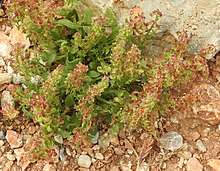Rumex bucephalophorus
Rumex bucephalophorus, also known as horned, red, or ruby dock is an annual herbaceous plant that is part of the family Polygonaceae.[1] The scientific name Rumex bucephalophorus was first described and published by Linnaeus in 1753 in Species Plantarum.[1] Other scientific names have also been given to Rumex bucephalophorus such as Bucephalophora aculeata and Lapathum bucephalophorum.[1] R. bucephalophorus is most commonly found in subcoastal or coastal regions, but also are "casual aliens", few and far between, among inland populations.[2] Rumex bucephalophorus is native to the Mediterranean Basin and grows best in areas with little human intervention.[3]
| Rumex bucephalophorus | |
|---|---|
 | |
| Scientific classification | |
| Kingdom: | Plantae |
| Clade: | Tracheophytes |
| Clade: | Angiosperms |
| Clade: | Eudicots |
| Order: | Caryophyllales |
| Family: | Polygonaceae |
| Genus: | Rumex |
| Species: | R. bucephalophorus |
| Binomial name | |
| Rumex bucephalophorus L. | |
Description
The stems of R. bucephalophorus are thin and branch off the base of the plant about 5 to 50 centimeters long. The leaves of the plant vary as they can be circular and ovate or lengthened and lancelate anywhere in between.[1] The pedicels are known to be heteromorphic often distinguishing this plant from others.[1] Flowers are often found in groups of 2 to 3 in clusters and are also often heteromorphic.[1] Like its leaves, the flowers of R. bucephalophorus often vary greatly but are generally triangular and 2–4 mm long.[1]
The Rumex bucephalophorus flowers appear red and blossom between the months of December and May.[4]
Distribution
The genus Rumex is mostly distributed throughout North America and Europe.[2] However, Rumex bucephalophorus flourishes in habitats that are quite sandy and rocky therefore it often is found by the sea.[4] The Atlantic coast of southwestern Europe, the northwestern region of Macaronesia and Morocco, and the coastlands of the Mediterranean Basin are where R. bucephalophorus is most widely distributed.[2]
Subspecies
Rumex bucephalophorus is unique as it is a polymorphic species resulting in 8 different subspecies as well as dozens of variants and subvariants.[5]
- Rumex bucephalophorus ssp. aegaeus
- Rumex bucephalophorus ssp. bucephalophorus
- Rumex bucephalophorus ssp. canariensis
- Rumex bucephalophorus ssp. graecus
- Rumex bucephalophorus ssp. fruticescens
- Rumex bucephalophorus ssp. gallicus
- Rumex bucephalophorus ssp. hipporegii
- Rumex bucephalophorus ssp. hispanicus
Uses
R. bucephalophorus does not have any known uses, but it is an edible plant.[4] There is a danger, however, because its leaves contain a high level of oxalic acid that can be potentially dangerous in large amounts.[4] This oxalic acid gives the leaves an acid-lemon flavor.[4]
References
- "Rumex bucephalophorus in Flora of North America @ efloras.org". www.efloras.org. Retrieved 2019-10-03.
- Talavera, Maria (December 2011). "Molecular phylogeny and systematics of the highly polymorphic Rumex bucephalophorus complex (Polygonaceae)". Molecular Phylogenetics and Evolution. 61 (3): 659–70. doi:10.1016/j.ympev.2011.08.005. PMID 21864695.
- Talavera, María (12 July 2012). "Evolution of dispersal traits in a biogeographical context: a study using the heterocarpic Rumex bucephalophorus as a model". Journal of Ecology. 100 (5): 1194–1203. doi:10.1111/j.1365-2745.2012.01999.x.
- "Rumex bucephalophorus red dock PFAF Plant Database". pfaf.org. Retrieved 2019-10-03.
- "Tropicos | Name - Rumex bucephalophorus L." www.tropicos.org. Retrieved 2019-10-03.